by DGR News Service | May 7, 2019 | Biodiversity & Habitat Destruction
By Will Falk and Sean Butler / Voices for Biodiversity
On December 18, 2018, the Center for Biological Diversity and the Wild Fish Conservancy threatened the Trump administration with a lawsuit under the Endangered Species Act (ESA) for allowing salmon fisheries to take too many salmon, which the critically endangered Southern Resident orcas depend on for food.
The impulse to protect the orcas is a good one. Southern Resident orcas are struggling to survive — only 75 remain. According to the statement by the Center for Biological Diversity and Wild Fish Conservancy, “The primary threats to Southern Resident killer whales are starvation from lack of adequate prey (predominantly Chinook salmon), vessel noise …that interferes with … foraging … and toxic contaminants that bioaccumulate in the orcas’ fat.”
You probably assume, when reading that list of primary threats to the orcas, that the threatened lawsuit would demand an end to these harmful activities. But it doesn’t. Instead, the organizations are merely asking the National Marine Fisheries Service — the agency responsible for issuing permits to Pacific coast fisheries — to deal with alleged violations of the ESA.
The Center for Biological Diversity and the Wild Fish Conservancy aren’t asking that activities harmful to Chinook salmon, and consequently to the Southern Resident orcas, be stopped. They aren’t asking for noisy vessels that disturb the whales’ foraging behaviors to be prohibited. They aren’t even asking for an end to the toxic contaminants that accumulate in the whales’ fat.
Why aren’t they asking for any of these things? Because under American law they aren’t allowed to ask for them.
All they are asking is that these harmful activities receive the proper permits.
Right now, laws like the Endangered Species Act are the main legal means for protecting threatened species and habitat in the United States. But these laws only allow us to challenge permit applications and ask that projects complete the permit process.
While it may hard to believe, these permits are designed to give permission to cause harm. Regulatory agencies only regulate the amount of harm that takes place. They do not, and cannot, stop ecocide. Instead they allow for softer, sometimes slower versions of ecocide.
To understand this, it helps to know a bit about how the Endangered Species Act actually works. The Act prohibits any person, including any federal agency, from “taking” an endangered species without proper authorization. “Take” is defined as: “to harass, harm, pursue, hunt, shoot, wound, kill, trap, capture, or collect, or to attempt to engage in any such conduct.”
You might expect that the Act completely prohibits any activity that “takes” an endangered species. But it doesn’t. Under the Act, federal agencies may harm members of an endangered species as long as the activity is “not likely to jeopardize the continued existence of any endangered species.”
While that may sound more promising, it isn’t. When a proposed action is likely to jeopardize an endangered species, the agency can then issue an Incidental Take Statement (ITS), which merely sets a limit on the number of individuals of an endangered species that can be taken.
In other words, a species that has already endured so much destruction can legally be further harmed if that harm is in compliance with certain terms and the correct forms are filled out.
So an ITS allows a federal agency to harm endangered species. But there are also Incidental Take Permits (ITPs). These allow private entities to harm endangered species. All a private entity needs to do to get an ITP is create a plan that purportedly minimizes and mitigates harm to an endangered species.
The irony is not lost on Professor J.B. Ruhl, who describes the situation in his aptly-titled law review article, “How to Kill Endangered Species, Legally”:
“Rather, when we strip away its noble purpose… at bottom the ESA is little different from the modern pollution control statutes which broadly prohibit a defined activity with one hand, then with the other hand give back authority to do the same activity under regulated conditions.”
In the original 1973 version of the Endangered Species Act, ITS and ITP exemptions did not exist. They are the result of amendments passed by Congress in 1982 to undermine several pro-environmental Supreme Court decisions that interpreted the Act as broadly protecting endangered species. Those amendments are a powerful and dangerous loophole.
In a 2011 report, a trial attorney with the Environmental Crimes Section of the U.S. Department of Justice, Patrick Duggan, found that ITPs are being issued at alarming rates — and with ever-broader scopes. “In the first decade after the 1982 Amendments, there were 14 ITPs issued, by August 1996, there were 179, and by April 2010, there were 946 approved by the U.S. Fish and Wildlife Service (FWS) alone.” Even FWS has acknowledged this trend of permissiveness, recently noting how the number of approved plans has “exploded.”
Most people mistakenly believe that regulations are being enforced by regulatory agencies. They’re not. Some environmental lawyers call this the “regulatory fallacy.” Not surprisingly, this drains focus from potentially more effective tactics by funneling it into a belief that government agencies will actually protect people and natural communities by denying permits.
The system isn’t working — and it’s very unlikely that it will protect the critically endangered Southern Resident orcas. But why doesn’t it work?
To begin to understand why the Endangered Species Act is failing, it’s helpful to acknowledge perhaps the most fundamental assumption of the Act and all similar pollution control statutes, as Professor Ruhl calls them. That assumption is that we have an inalienable right to use the natural world for our own purposes.
The answer to the regulatory fallacy, then, is to turn this on its head. If we truly want to protect endangered species like the Southern Resident orcas, our laws cannot treat them and their essential food source as objects or property. Instead, we must acknowledge their inherent rights to exist, and create laws that uphold and enforce those rights. True sustainability requires transforming the status of nature from a legal object to a rights-bearing subject.
This transformation begins with granting nature the legal right to challenge the conduct of someone else in court. As Supreme Court Justice William O. Douglas wrote in his famous 1972 dissent in Sierra Club v. Morton, this “would be simplified and also put neatly in focus if we fashioned a federal rule that allowed environmental issues to be litigated before federal agencies or federal courts in the name of the inanimate object about to be despoiled, defaced, or invaded by roads and bulldozers…”
In the US, the rights-based approach has been pioneered by the Community Environmental Legal Defense Fund (CELDF), a nonprofit, public interest law firm. Since 2006, CELDF has helped dozens of communities in ten states enact rights of nature laws. Their model uses a “Community Bill of Rights,” which declares that citizens of the city or county have a right to clean air, clean water, etc., and that the natural communities within its borders have a right to exist, flourish, regenerate and naturally evolve. Natural communities are specifically granted legal standing and citizens are empowered to bring lawsuits to enforce these rights. This is similar to the way guardians represent children in court.
Southern Resident orcas range from as far south as California and along the coasts of Oregon and Washington. If the communities along the West Coast had rights of nature laws, they could now bring a lawsuit on behalf of the Southern Resident orcas, with claims that fishery practices, dams, shipping activities and pollution violate the whales’ rights to exist, flourish, regenerate and naturally evolve. They could ask the courts to completely ban harmful fishery practices in order to protect the rights of nature, and to order those responsible for harm to pay for the regeneration of the natural community. They could seek this relief from the courts because the fundamental rights of the ocean and its residents are being violated.
What’s more, because the plaintiff in such a lawsuit would be a whole population of salmon or whales, or even an entire ecosystem like the Salish Sea, the damages awarded would be measured according to the losses suffered by the natural communities themselves. And any award of damages would go toward the restoration of those communities, rather than to human plaintiffs who might not use it to benefit the ecosystem that has been damaged.
“We’d be having very different conversations and much more effective results if we approached recovery with the orcas’ best interests in mind,” says Elizabeth M. Dunne, Esq., who is part of a coalition that helped draft the Declaration for the Rights of the Southern Resident Orcas, led by the grassroots community group, Legal Rights for the Salish Sea. Dunne explains that, “by signing the Declaration, we want people, organizations and governments to recognize that the Southern Residents’ have inherent rights, to recognize that we have a responsibility to protect those rights, and to commit to taking concrete actions to protect and advance those rights.”
Environmentalists who engage within today’s regulatory framework and rights of nature proponents begin in the same place. They both want to protect the natural world. But the way they frame the issue could not be more different. Environmentalists who rely on regulatory laws frame the issue as one of improperly prepared reports or how many parts per million of toxins may permissibly be released into water supplies. For example, the Center for Biological Diversity and Wild Fish Conservancy want to protect the Southern Resident orcas, but all they can ask for under the ESA is that the responsible federal agency “reinitiate and complete consultation on the Pacific Coast salmon fisheries” with new scientific information.
Rights of nature proponents, on the other hand, affirm nonhumans’ value as subjective beings, framing the issue in terms of whether a proposed action violates their fundamental rights. Though we cannot put an orca on the witness stand to testify about the impacts that the National Marine Fisheries Service’s plan has on her species, empowering humans to speak for her through enforcement of her legal rights brings nature’s voice directly into the courtroom.
Originally listed as endangered in 2005, Southern Resident orca numbers have continued to decline. The Center for Biological Diversity reports that the population is at its lowest point in 34 years. And, “In 2014, a population viability study estimated that under status quo conditions, the Southern Resident killer whales…would reach an expected population size of 75 in one generation (or by 2036).” Instead, it was just four years later that the Southern Resident orca population stood at 75.
In the end, the only measure of success in this case should be the whales’ recovery. The people of Washington aren’t concerned that regulations haven’t been followed— we’re concerned that our neighbors, the Southern Resident orcas, are starving. We’re horrified that these beautiful animals’ right to life is not being respected and that their ecosystem is being destroyed. And we’re outraged because deep down we believe that the natural world does have inherent value — and therefore inherent rights.
It’s time to stop begging for regulatory table scraps. It’s time to have the courage of our convictions and create new laws that recognize the inherent rights of the Southern Resident orcas and the Salish Sea as a whole to exist, flourish and evolve.

by Deep Green Resistance News Service | Sep 7, 2018 | Listening to the Land
Featured image: Glen Canyon Dam on the Colorado River. © Michelle McCarron
by Will Falk / Voices for Biodiversity
I need to come clean. When I joined Colorado River Ecosystem v. Colorado, the first-ever federal lawsuit to seek personhood and the rights of nature for a major ecosystem, my intentions were not completely sincere. The truth is, I never thought we had a chance in hell. I saw the lawsuit as an opportunity to guide concerned people through a process that would shatter their false hopes, replace them with experiential knowledge of the vast difficulties inherent in working for change within the legal system and catalyze more effective action.
The lawsuit failed, of course. The Colorado Attorney General privately threatened the attorney representing us, Jason Flores-Williams, with sanctions if he did not withdraw the case. When he refused, the Attorney General formally filed a request for sanctions with the court and a motion to dismiss in the same afternoon. Flores-Williams, afraid that he could not respond adequately to both the sanctions and the motion to dismiss, voluntarily withdrew the case.
When filing a lawsuit, however, it’s best not to proclaim publicly that you expect the case to fail. Judges jealously guard their calendars from anything they perceive to be a waste of time. Corporate and government lawyers vigilantly monitor individuals involved in cases filed against them for any opportunity to argue that novel legal theories like the rights of nature are frivolous, to label them as attempts to harass corporations or government, and to demand that they be punished with sanctions. Media pundits search for audio clips and social media posts to take out of context while accusing grassroots groups of filing lawsuits as a backhanded fundraising ploy.
At the same time, and in order to shatter as many hopes as possible, it was necessary to attract attention. No one likes a loser. If our supporters caught so much as a whiff of my true disbeliefs, when the case failed, they could mistake the failure as the result of the half-assed efforts of activists who weren’t truly committed, instead of the result of a legal system designed to protect exploitation of the natural world.
So I suspended my disbelief and dove zealously into the work. For four months, the lawsuit was my full-time job. I sifted through case law for opinions supporting our position. I wrote a portion of the document, called the “complaint,” that signaled the official filing of the lawsuit. I wrote a series of articles describing the need for the rights of nature. I gave interviews to journalists, radio hosts and members of Comedy Central’s The Opposition production team.
And I bit my tongue over and over again.
In the five weeks before the case was dismissed, I put 4,000 miles on my 2004 Jeep Grand Cherokee traveling with photographer Michelle McCarron around the Colorado River Basin. After all that stress, my poor Jeep’s transmission blew up yesterday, so I have nowhere to go and nothing to do but reflect. With time so short and the need for effective action so great, I wonder if I wasted my time appealing to a legal system that exists to protect those destroying the natural world. I wonder if I betrayed the trust of the good people rooting so hard for the lawsuit to succeed. Worst of all, I wonder if I betrayed the river.
***
I bit my tongue on the steps of the Alfred A. Arraj Federal Courthouse in Denver, for example. I stood before a crowd gathered to hear me speak about the lawsuit. We were supposed to have a hearing, but the court had postponed it at the last minute. With so many of us traveling to Denver from across the Colorado River Basin, we decided to proceed with the press conference anyway.
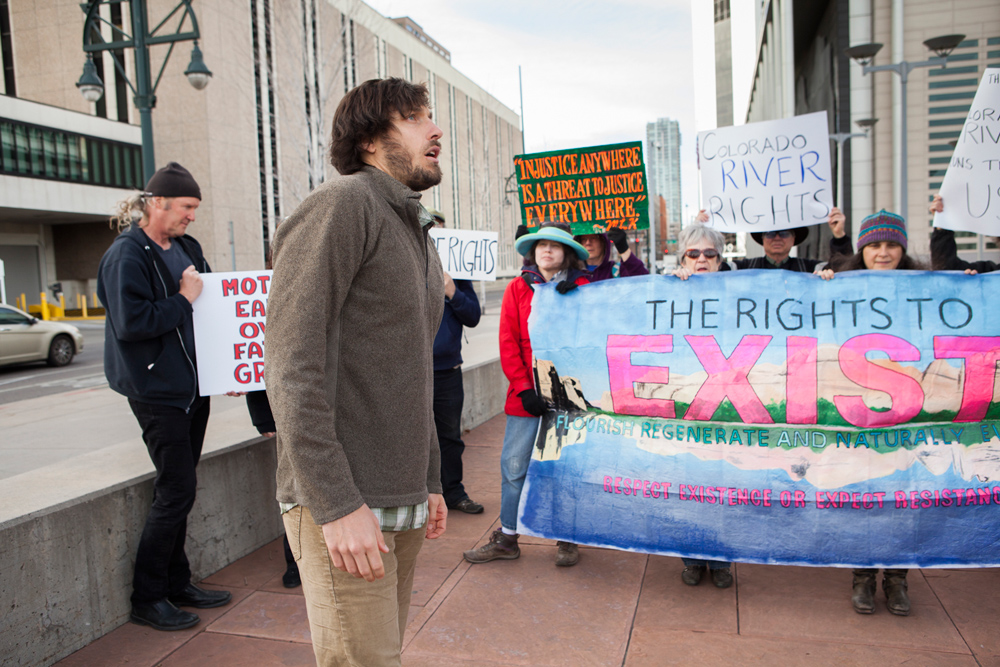
© Michelle McCarron
It wasn’t the anxiety that public speaking can induce that produced the tremor in my hand, the acid in my gut and the quiver in my voice. It was a simple question, unresolved: Is it dishonest to speak of hope when you feel none?
I began my speech explaining that I had arrived there after spending three weeks with the river. I recounted the violence I witnessed in La Poudre Pass, where the Grand Ditch lies in wait to steal the Colorado River’s water moments after the union of snowpack, sunshine and gravity gives her birth. I reported the energy expended in pumping the river’s water uphill from Lake Granby reservoir to Shadow Mountain reservoir and then into Grand Lake before the Alva B. Adams tunnel drags the water 13 miles across the Continental Divide and beneath Rocky Mountain National Park to meet Front Range demands. I described the view from Palisade, Colorado, where peaches are grown in the middle of the desert and crisscrossing canals, seen from the mountains, appear as vast, mechanical tattoos sewn into the flesh of the land.
I paused at this point, knowing that after presenting my audience with this series of distressing images, I was supposed to leave them with a positive message. While I reflected on what I had seen and said, however, I felt the river’s truth spill over me.
For weeks, I thought I had been listening to the Colorado River. But she isn’t a river anymore. Not truly. She has been so diverted and dammed, experienced so much extraction and exploitation, that the best way to describe her is not as a river, but as an industrial project, as a series of tunnels, concrete channels and canals, as another tortured corpse stretched across civilization’s rack.
While this realization washed over me, I considered our lawsuit and the rights of nature. I wondered if it is possible to grant rights to a ghost. I questioned whether the Colorado River could ever recover from what’s been done to her. Grief threatened to overwhelm me, to silence me in despair. If I had been by myself, caught in the flow of these emotions in private, or if I was simply being honest, I would have fallen to the concrete and wept. I steadied myself and as the despair trickled away, rage rushed in to take its place. That rage burned with the heat of the desert sun reflected in the Colorado’s face and I knew that, ghost or not, she who haunts is not dead.
But, again, I said nothing of her rage, of her attempts to knock down dams, of her furious floods. I said nothing to acknowledge her ghost. Instead, in calm, reasonably legal tones, I urged the crowd to support the rights of nature.
***
The case is now finished. I can stop biting my tongue and spit the blood out. I can be honest. If I betrayed you, I am sorry. If I betrayed the river, I beg forgiveness. As an act of penance, I offer the stories that follow. These stories are what I really think. These stories are what I wish I said when the journalists were scribbling down my words, when I sat, live and on air, at the radio microphones, and when the cameras were recording. These stories are the truth.
We listed the river as the only plaintiff, so it could be properly said that the Colorado River herselfwas suing the State of Colorado. Major ecosystems are not currently considered capable of bearing rights or filing their own lawsuits under American law, so I agreed, with four others, to serve as a “next friend” of the Colorado River. Similar to guardians ad litem, next friends represent the interests of those deemed legally incompetent, such as children, the mentally disabled and rivers.
Simply put, next friends speak for those who can’t speak for themselves.
On a general level, it’s not difficult to understand the Colorado River’s interests. A simple Google search will tell you that pollution kills the river’s inhabitants, climate change threatens the snowpack that provides much of the river’s water, and dams prevent the river from flowing to the sea in the Gulf of California. But, friendship, even legal “next friendship,” entails an intimate and personal relationship. To best represent the Colorado River’s interests, to be her friend, I wanted to build this intimate, personal relationship with her. To build a relationship with someone is to speak with her, to spend time with her, to listen to her. And that’s what I did.
My trip with Michelle around the Colorado River Basin was guided by two questions. Everywhere we went, I asked the Colorado River: “Who are you? And, what do you need?” I asked these questions out loud, so she could hear them. I will not apologize for talking with a river.
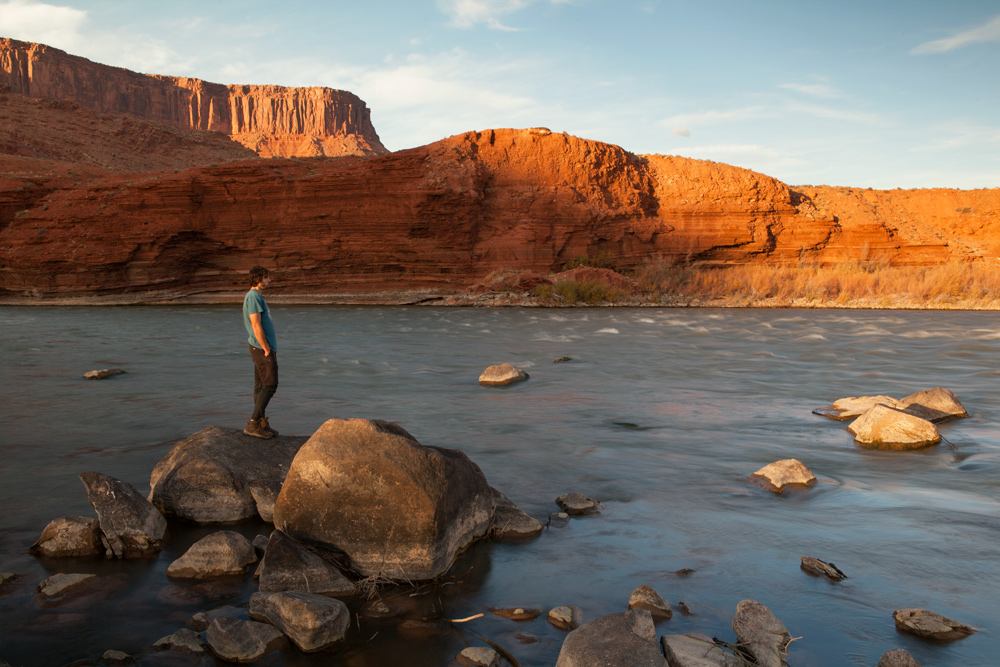
© Michelle McCarron
The Colorado River speaks, but apparently not in a language many humans understand. Water is one of life’s original vernaculars, and the Colorado River speaks an ancient dialect. Snowpack murmurs in the melting sun. Rare desert rain drops off willow branches to ring across lazy pools. Streams, running over dappled stones, sing treble while distant falls take the bass.
I am human, so I am an animal. Even though the colonization of generations of my ancestors, personal trauma and cultural conditioning threaten to deafen me, I am still capable, through my animal body, of hearing the languages of life. And I believe you are capable, too. If you’ll only try.
Though the lawsuit failed, I made a friend. When your friend is in grave danger, you do everything in your power to protect her. If you don’t, you cannot call yourself her friend. The Colorado River is in grave danger and as her friend, I know I must do everything I can to protect her. If my animality gives me the ears to listen, friendship requires that I find the tongue to translate the languages of life.
Human, animal, friend…these three existences combine and compel me to translate her voice from the languages of life into English.
***
To truly understand someone, you must begin at her birth. So, Michelle and I spent two days looking for the Colorado River’s headwaters in the cold and snow above La Poudre Pass on the north edge of Rocky Mountain National Park. The pass was accessible by an unpaved, winding, pot-holed trek named Long Draw Road. It took us fourteen miles through pine and fir forests and past the frigid Long Draw Reservoir before ending abruptly in a flat where the red trunks and brown branches of winter willows braced themselves against the breeze.
The road was covered in an inch of frosty mud that required slow speeds to avoid sliding into roadside ditches. The road’s ruggedness and incessant bumps combined with sub-freezing temperatures to ask us if we were serious about seeing the river’s headwaters. I was worried that Michelle’s ’91 Toyota Previa might struggle up the pass, but the van continued to live up to the Previa model’s cult status.
Long Draw Road foreshadowed the violence we would find at the river’s headwaters. Swathes of clearcut forests escorted us along the road to the pass. The Forest Service must have been too lazy to remove any single trees that fell on the road because their employees had simply chainsawed every tree within fifty yards of the road. About three miles from the road’s end, we ran into a long, low dam trapping mountain runoff into Long Draw Reservoir. We had been expecting to find wilderness in La Poudre Pass, so encountering the dam felt like running into a wall in the dark.
The clearcuts, dam and reservoir were grievous wounds, but none of them were as bad as the Grand Ditch. We walked a quarter-mile from the end of Long Draw Road and found a sign marking the location of the river’s headwaters. On our way to the sign, we crossed over a 30-foot deep and 30-foot wide ditch pushing water from west to east. We were on the west side of the Continental Divide, where water naturally flows west, so we contemplated what black magic engineers had employed to achieve this feat. The ditch was as conspicuous in La Poudre Pass as a scarred-over gouge on a child’s face.
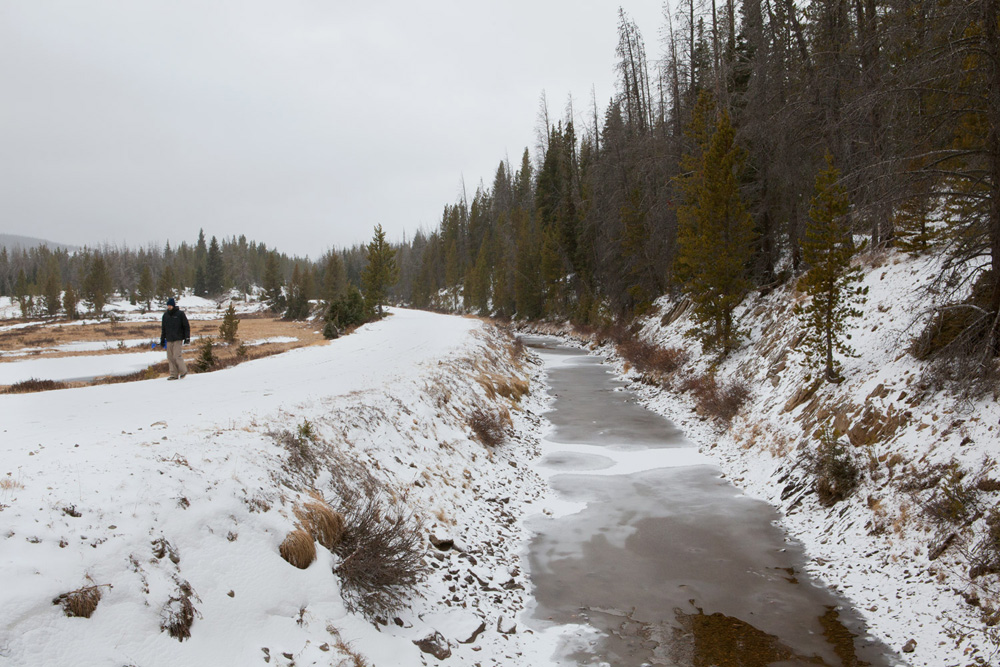
© Michelle McCarron
The Grand Ditch was begun in the late 1880s, dug by exploited crews armed with hand tools and risky dynamite. It was built to carry water, diverted from the Colorado River’s headwaters, east to growing cities on Colorado’s Front Range. About two feet of swift water ran through the ditch. Even before melting snowpack forms the tiny mountain streams identifiable as the Colorado River’s origins, water is stolen from her. Pausing in a half-foot of powder, I wondered whether the water stored here would end up on a Fort Collins golf course or stirred by the fins of a vaquita porpoise in the Gulf of California.
I asked theColorado Riverfor the tale of her nativity. She described her birth from a wild womb formed by the oceans, the sun’s consistency, heavy winter clouds, tall mountain peaks and snowpack. She rues that heremergence from this womb led immediately to her exploitation. And the young Colorado River hates the violence that will follow her the rest of her life.
***
In most places, life protects themodern human’s fragile sense of self-importance by veiling the weight of time in the soft accumulation of soil, by disguising the vastness of the universe in the reassuring consistency of an undisturbed horizon and by salving existential angst with a diversity of nonhuman companions. There are places, however, where life refuses to disguise herself and human self-importance disintegrates.
The red rock deserts and canyon lands of southeastern Utah, where we followed the Colorado River, are some of these places. The reality of time, frozen and piled where the land was rent into mesas and plateaus, crashes down on human consciousness where human bones shiver in the shadows and foreshadows are whispered by stones, boulders and the bones of the land.
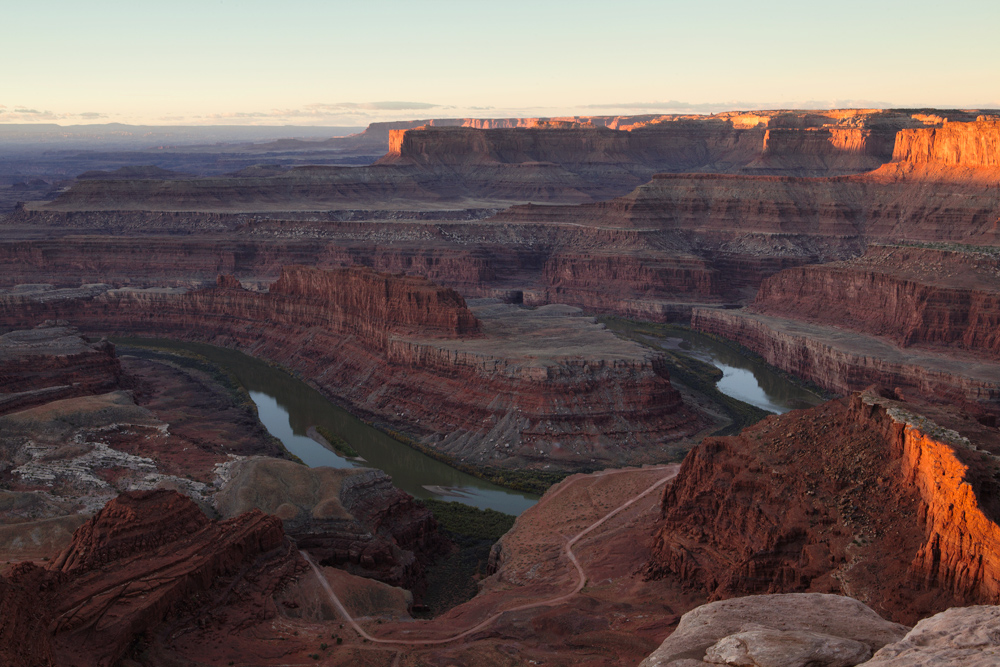
© Michelle McCarron
She beckoned us south through these lands. She fled through the sheer red rock walls that she sculpted as monuments to her power. She paused, at times, in warm pools, to let the colors of stone reflect from her face and to rejoice in her own beauty. To interpret her work as vanity is to misunderstand; only her creations are worthy of her celebration. The waters flowing through our bodies coursed against our skin and tugged on our veins, yearning to mingle with their kin. We ached with regret for the moment life would necessarily drag us from her banks.
Mesmerized and seeking the confluence of the Green and Colorado Rivers, we got lost in Canyonlands National Park. We failed to reach the confluence, and thus failed to speak with the two rivers. At first, we were angry with ourselves. We ended up hiking close to fourteen miles in seven hours, up canyon walls abruptly rising six or seven hundred feet, through a rainstorm and across canyon floors covered in several inches of loose sand using muscles we forgot we had. We thought we had done it all for nothing. Worst of all, feeling a responsibility to tell the Colorado River’s story, we thought that we had let the river down.
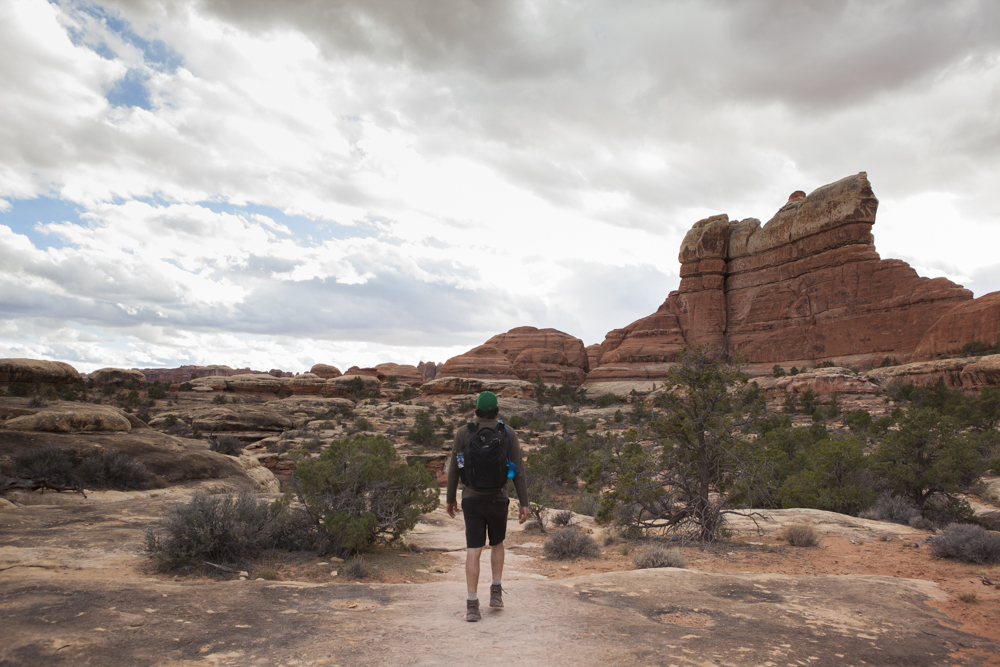
© Michelle McCarron
But the deeper I think about it, the clearer an image of the river, waving through the orange sunshine of a desert dusk, becomes. She seems to smile with the compassionate gleam of a wise elder. “You should have known,” she says. And now I do: We did not simply miss the cairns, lose the trail, and end up five miles south of the confluence and six miles from our cars after sunset. No, we lost more than the trail. We lost our self-importance. And only humility remained.
***
Water is life. But water is also death. Water brings a pleasant taste to the parched tongue, but water also brings stinging numbness to the warm-blooded. Water taken through the esophagus brings hydration. Water taken through the lungs brings suffocation. Water may be disrespected for a time, but the longer the passage of water is hampered, the angrier water becomes. Water has a long memory and, where others forget, water carries pollutants and poisons for decades.
When I think about what it would mean to fully recognize the rights of the Colorado River to exist, flourish, regenerate and naturally evolve, I know the river will demand a reckoning. I know this lyrically and I know this ecologically. Lyrically, the river is full of righteous rage. Ecologically, too many humans have come to depend on the exploitation of the river and the rest of the natural world. The balance that must be achieved will come with profound pain. Humans will die, their lifestyles will be dramatically changed and those who require the gifts of civilization will see those gifts taken.
The black waters of the dammed Blue and Colorado Rivers stroked the Dillon Reservoir walls with their dark thoughts and taught me these lessons. It was several hours after sunset and well below freezing. A certain morbidity rose from the artificial lake and crystallized to hang in the air. Somewhere out of sight, but perilously near, I could feel the stirrings of anger. I sensed that the anger was slow to swell, but irresistible when fully aroused. I was mesmerized by the stars spilling over ripples and by the crescent moon’s silver threads, two nights from new, dancing across the water. In the town of Dillon below, harsh electric lights sparked and crackled with a troubled tension.
The images came unbidden. The first faint crevice appeared in the earth-filled wall. Water hissed as it pushed through. Rivulets appeared as tears rolling down the dam’s face. Then, a series of sharp cracks rang out like the reports of heavy ordnance announcing the onset of battle. Earth and stone blasted away to fall into the valley. Water rushed into Dillon. Poles holding power lines snapped like toothpicks. Chunks of asphalt were ripped up. Automobiles flipped and tumbled like pebbles on a creek bed. Factory outlet stores, gas stations and multistory hotels were washed away.
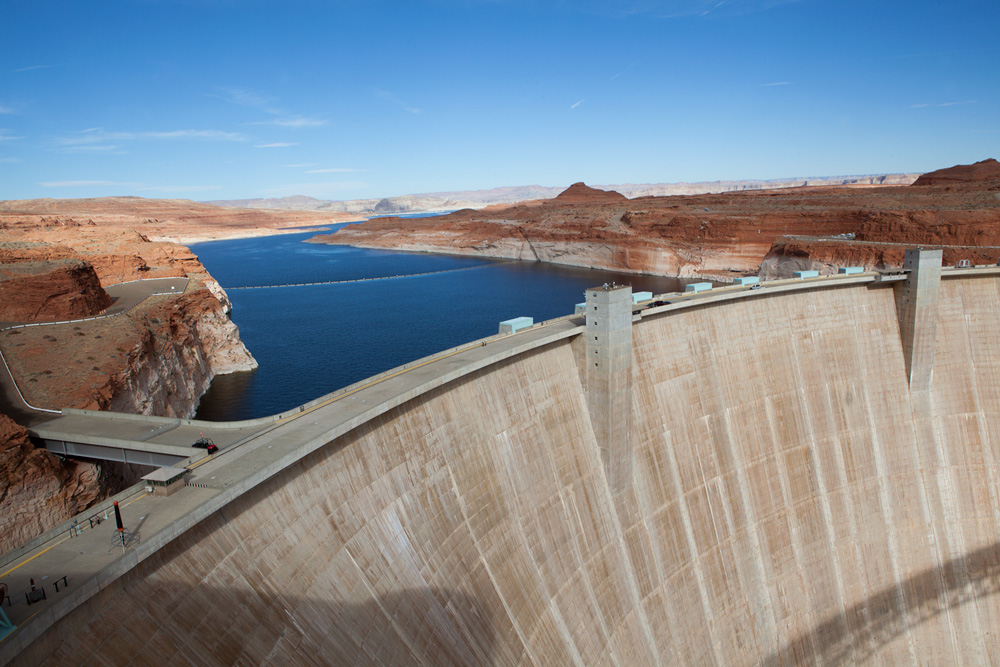
© Michelle McCarron
The white torrents that cascaded from the broken dam were flecked with joy. The waters retook the Blue River’s original path. The waters from the Colorado, knowing they would never rejoin their mother, were gladly adopted by the Blue. It was all over in a matter of minutes. This sudden demonstration of natural power passed and a quiet peace settled where Dillon once stood. The peace wasn’t without pain. Human bodies floated facedown among the wreckage. The water regretted the deaths, but knew the human bodies would be broken down and used to heal the wounds humanity had created.
As the vividness of the images faded, I was left with the echo of a warning. I recalled all the dams in the Colorado River Basin, all dams everywhere, and I prayed that a peace could be made with the dammed waters of the world.
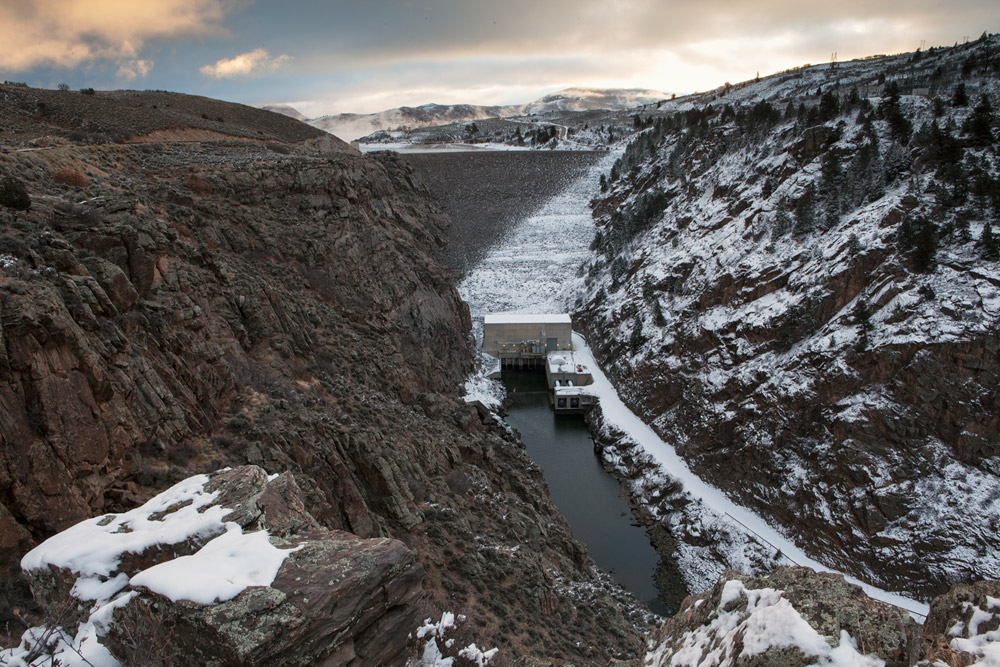
© Michelle McCarron
***
I have seen the silver sparks of minnows playing under brown stones. I have watched the wind shower gray pools with gold cottonwood leaves. I have been washed away in the vertigo caused by the river’s speed conflicting with the primordial stillness of canyon walls. Arundhati Roy wrote, “Once you see it, you can’t unsee it. And once you’ve seen it, keeping quiet, saying nothing, becomes as political an act as speaking out. There’s no innocence. Either way, you’re accountable.”
I’ll never be able to drive past a dam in the Colorado River Basin and ignore the highly endangered bonytail chub who can no longer visit most of their traditional spawning beds. I’ll never be able to read the billboards praising the peaches of Palisade, Colorado, or the melons of Green River, Utah, without remembering dried up willow forests where the songs of nimble southwestern willow flycatchers have fallen silent. And whenever I close my eyes to recall the Colorado River, that blue ribbon twisting through rocky mountains and red rock canyons, I won’t be able to unsee her suffering.
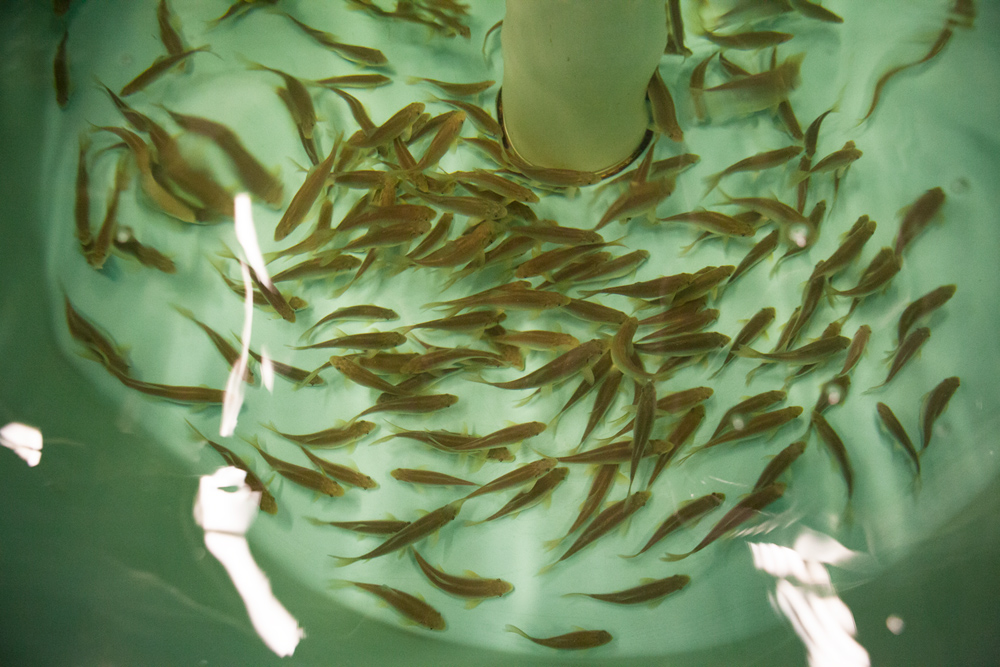
© Michelle McCarron
As I process the last four months, I’m left with Roy’s brilliant words: I am no longer innocent and it is time to be accountable. Disbeliefs may only be suspended for so long before they slither through slits in the veil separating consciousness and subconsciousness as anxieties. Anxieties, similarly, may only be silenced for so long before they push through lips and teeth as words.
Disbeliefs, anxieties and words, when true, spawn in reality. The reality is that the loss of life on Earth currently outpaces our various resistance movements’ responses. Those in power enforce infinite growth on a finite planet. The planet’s life-support systems are resilient, but they can be pushed beyond their ability to recover. This means there is a deadline. While it is unclear when that deadline will pass, the deadline exists. If we do not stop the assaults on the planet’s life-support systems like the Colorado River, life on Earth may be impossible for a very long time, if not forever. We have little time to waste on ineffective tactics.
Hear the white crash of her torrents on the boulders she drags through the desert, feel the unyielding red rock she pushes through, lose your balance in the impatience of her swift streams, and you’ll know: The Colorado River needs to provide her waters and yearns for her home in the sea.
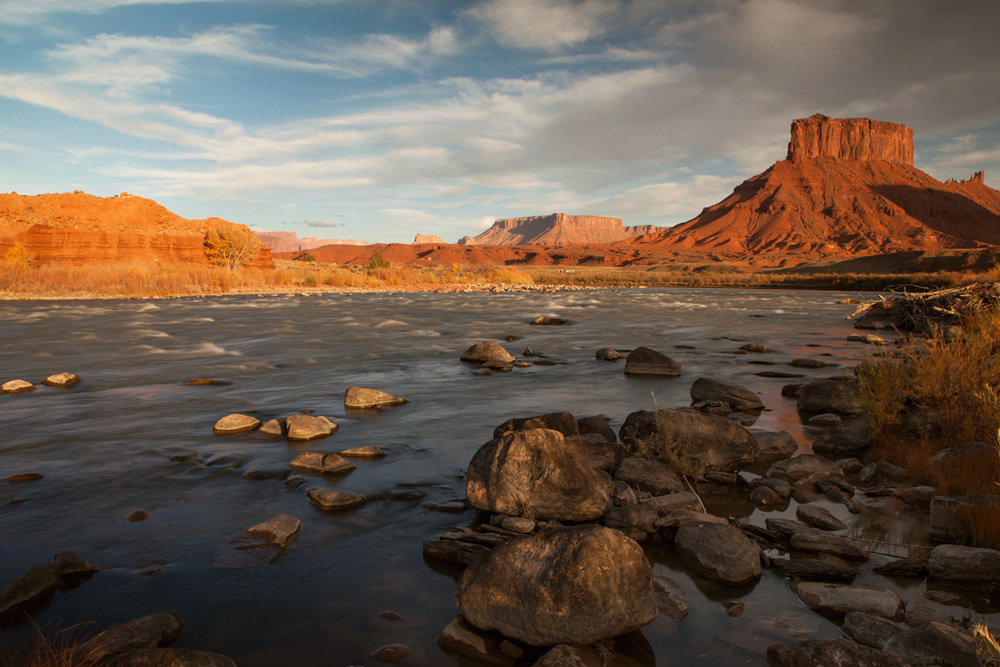
© Michelle McCarron
In all my time spent listening, I did not hear her speak of a judge’s gavel, of evidentiary proceedings or of the State of Colorado’s motion to dismiss. She cited no precedent, no binding legal authority and no argument made by silver-tongued attorneys. She did not fear questions of jurisdiction or the threat of sanctions.
No, her fears are physical and real. She fears poisonous mercury and too much selenium. She fears climate change causing less and less snow to fall and depriving her of replenishment. She fears dams.
If I could start the lawsuit all over again, maybe I would refuse the interviews, refuse to write the complaint, refuse to write anything at all. Instead, I would insist that you sit on the river’s banks, listening. And if you hear the Colorado River’s rage as she slaps the face of a dam, you’ll know that court orders aren’t the only way dams fall.
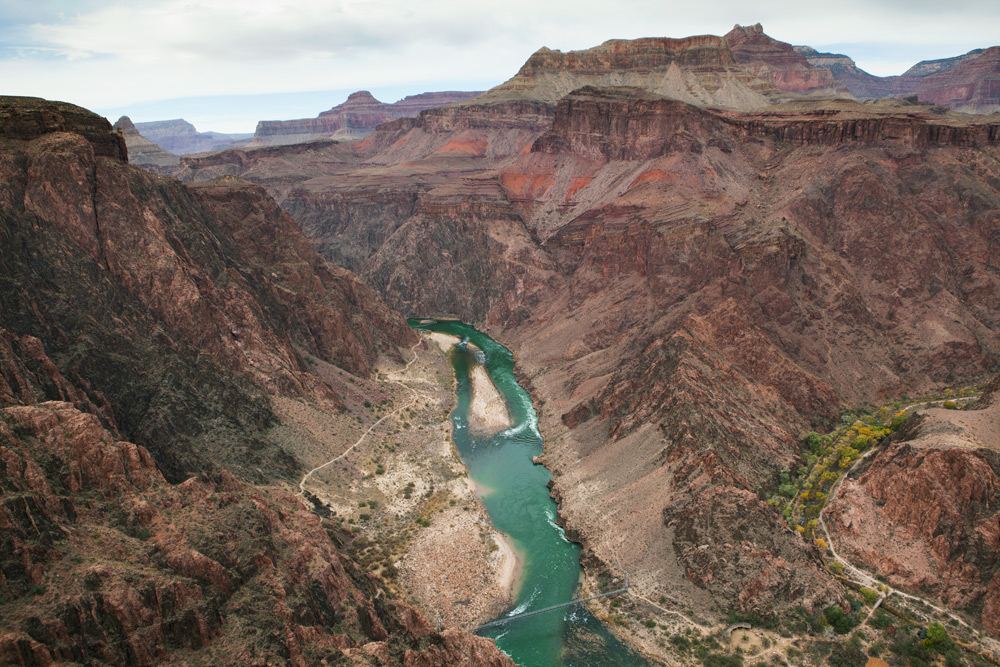
© Michelle McCarron
This article and the photos therein are the sole property of Will Falk and © Michelle McCarron and may not be reproduced or republished elsewhere without the explicit permission of the author or photographer.
This article originally appeared at Voices For Biodiversity. VFB is grateful to the Community Environmental Legal Defense Fund (CELDF) for introducing us to Will Falk and Michelle McCarron. CELDF is doing excellent work helping communities fight for nature’s rights and we are honored to collaborate with their team.

by Deep Green Resistance News Service | Jun 15, 2018 | Movement Building & Support
by Deep Green Resistance
Next weekend, Deep Green Resistance is hosting an advanced training in direct action, revolutionary strategy, tactics, and organizing taking place next to Yellowstone National Park. If you wish to attend, sign up now. We also have one free scholarship available that covers the cost of attending. Email us at training [at] deepgreenresistance [dot] org if you wish to apply for this scholarship.
Click here to register
Our trainers include:
Sakej Ward
 Sakej (James Ward) belongs to the Wolf Clan. He is Mi’kmaw (Mi’kmaq Nation) from the community of Esgenoopetitj (Burnt Church First Nation, New Brunswick). He is the father of nine children, four grandchildren. He resides in Shxw’owhamel First Nation, B.C. with his wife Melody Andrews and their children. Sakej is a veteran of both the Canadian and American militaries. He finished his military career at the rank of Sergeant in an elite Airborne unit. Sakej holds a Bachelor’s Degree in Political Science with a specialization in International Relations and a Master’s of Arts Degree in Indigenous Governance. Sakej has a long history of advocating and protecting First Nations inherent responsibilities and freedoms, having spent the last 24 years fighting the government and industry. Having taught, organized, advised and led various warrior societies from all over Turtle Island down into Guatemala and Borike (Puerto Rico) Sakej has made warrior-hood his way of life. He has been on over a dozen warrior operations and countless protest actions. He dedicates all his time to developing warrior teachings and instructing warrior societies from all over.
Sakej (James Ward) belongs to the Wolf Clan. He is Mi’kmaw (Mi’kmaq Nation) from the community of Esgenoopetitj (Burnt Church First Nation, New Brunswick). He is the father of nine children, four grandchildren. He resides in Shxw’owhamel First Nation, B.C. with his wife Melody Andrews and their children. Sakej is a veteran of both the Canadian and American militaries. He finished his military career at the rank of Sergeant in an elite Airborne unit. Sakej holds a Bachelor’s Degree in Political Science with a specialization in International Relations and a Master’s of Arts Degree in Indigenous Governance. Sakej has a long history of advocating and protecting First Nations inherent responsibilities and freedoms, having spent the last 24 years fighting the government and industry. Having taught, organized, advised and led various warrior societies from all over Turtle Island down into Guatemala and Borike (Puerto Rico) Sakej has made warrior-hood his way of life. He has been on over a dozen warrior operations and countless protest actions. He dedicates all his time to developing warrior teachings and instructing warrior societies from all over.
Kara Dansky
 Kara Dansky is an independent consultant and the founder of One Thousand Arms. One Thousand Arms consults with organizations in conducting research and policy analysis on criminal and racial justice topics, including policing, bail and pretrial, sentencing and corrections, mass incarceration, drug policy, immigration policy, and others. She is also a radical feminist and serves on the Board of the Women’s Liberation Front. Kara created Gender Critical Lawyering in order to bring radical feminist arguments before the Court. She has previously served as Special Advisor at the New York City Mayor’s Office of Criminal Justice, Senior Counsel at the American Civil Liberties Union’s Center for Justice, Senior Advisor at the DHS Office for Civil Rights and Civil Liberties, Executive Director of the Stanford Criminal Justice Center, and Staff Attorney at Society of Counsel Representing Accused Persons. She earned her J.D. from the University of Pennsylvania Law School and her B.A. from the Johns Hopkins University, both cum laude.
Kara Dansky is an independent consultant and the founder of One Thousand Arms. One Thousand Arms consults with organizations in conducting research and policy analysis on criminal and racial justice topics, including policing, bail and pretrial, sentencing and corrections, mass incarceration, drug policy, immigration policy, and others. She is also a radical feminist and serves on the Board of the Women’s Liberation Front. Kara created Gender Critical Lawyering in order to bring radical feminist arguments before the Court. She has previously served as Special Advisor at the New York City Mayor’s Office of Criminal Justice, Senior Counsel at the American Civil Liberties Union’s Center for Justice, Senior Advisor at the DHS Office for Civil Rights and Civil Liberties, Executive Director of the Stanford Criminal Justice Center, and Staff Attorney at Society of Counsel Representing Accused Persons. She earned her J.D. from the University of Pennsylvania Law School and her B.A. from the Johns Hopkins University, both cum laude.
Rachel Lima
Rachel Lima (Charlie Rae) is a freelance writer for The Fifth Column and a dedicated independent journalist who has taken on the topic of transgenderism. Growing up with gender dysphoria, Rae speaks from the perspective of a tomboy who evaded the grips of this fad by a decade. Rae is a Tau Sigma honors student from NCSU intermittently studying communication, and a grassroots activist who has worked on everything from on-the-ground coverage, to local elections, to door knocking, to fundraising, to social media campaigns, to being a student senator representing her college body, to interviewing for local independent media, to guest lecturing at University, to photographing for the resistance, etc. Rae has developed an encompassing resistance seminar so that DGR and its members will have the tools and the mindset to incorporate resisting transgenderism into their approach.
Will Falk
 Will Falk is a lawyer and writer living in Heber City, UT, on occupied Ute territory. A graduate of the University of Wisconsin-Madison Law School, and a former public defender, his legal practice is committed to protecting human and non-human communities. The natural world speaks and Will’s work is how he listens. His writing has been published by the Dark Mountain Project, Earth Island Journal, CounterPunch, Whole Terrain, CATALYST Magazine, and the San Diego Free Press, among others.
Will Falk is a lawyer and writer living in Heber City, UT, on occupied Ute territory. A graduate of the University of Wisconsin-Madison Law School, and a former public defender, his legal practice is committed to protecting human and non-human communities. The natural world speaks and Will’s work is how he listens. His writing has been published by the Dark Mountain Project, Earth Island Journal, CounterPunch, Whole Terrain, CATALYST Magazine, and the San Diego Free Press, among others.
Max Wilbert
 Max Wilbert is a third-generation organizer who grew up in Seattle’s post-WTO anti-globalization and undoing racism movement. He holds a Bachelor’s Degree in Environmental Communication and Advocacy from Huxley College. He lives in rural Oregon. Max has a 15-year history as an organizer and revolutionary. He is a co-founder of Deep Green Resistance and longtime board member of a small, grassroots environmental non-profit with no employees and no corporate funding. His first book, a collection of pro-feminist and environmental essays, was recently released. He is also the co-author of the forthcoming book “Bright Green Lies,” which looks at the problems with mainstream so-called “solutions” such as solar panels, electric cars, recycling, and green cities. The book makes the case that these approaches fail to protect the planet and aim at protecting empire from the effects of peak oil and ecological collapse. He has participated in countless protests and more than ten direct actions, and been a part of multiple campaigns and land defense efforts. He has organized training for activists and revolutionaries in 10 states and in Canada.
Max Wilbert is a third-generation organizer who grew up in Seattle’s post-WTO anti-globalization and undoing racism movement. He holds a Bachelor’s Degree in Environmental Communication and Advocacy from Huxley College. He lives in rural Oregon. Max has a 15-year history as an organizer and revolutionary. He is a co-founder of Deep Green Resistance and longtime board member of a small, grassroots environmental non-profit with no employees and no corporate funding. His first book, a collection of pro-feminist and environmental essays, was recently released. He is also the co-author of the forthcoming book “Bright Green Lies,” which looks at the problems with mainstream so-called “solutions” such as solar panels, electric cars, recycling, and green cities. The book makes the case that these approaches fail to protect the planet and aim at protecting empire from the effects of peak oil and ecological collapse. He has participated in countless protests and more than ten direct actions, and been a part of multiple campaigns and land defense efforts. He has organized training for activists and revolutionaries in 10 states and in Canada.
Mike Bucci
 Mike Bucci is an environmental activist with Deep Green Resistance. He also helps community-based organizations develop affordable housing. He lives in a small cooperative of “homesteaders” in NY City (originally settled by the Leni Lenape tribe), and in the woods in an upstate NY watershed area surrounded by acres of old growth and farmland. Currently, he’s focused on promoting more effective activism against the industry’s build out of fossil fuel infrastructure, and fighting to end institutionalized racism, while building communities of resistance. In solidarity with radical feminists he supports the end of patriarchy and gender. In the past, he co-founded both NY Men Against Sexism, and Men Against Pornography.
Mike Bucci is an environmental activist with Deep Green Resistance. He also helps community-based organizations develop affordable housing. He lives in a small cooperative of “homesteaders” in NY City (originally settled by the Leni Lenape tribe), and in the woods in an upstate NY watershed area surrounded by acres of old growth and farmland. Currently, he’s focused on promoting more effective activism against the industry’s build out of fossil fuel infrastructure, and fighting to end institutionalized racism, while building communities of resistance. In solidarity with radical feminists he supports the end of patriarchy and gender. In the past, he co-founded both NY Men Against Sexism, and Men Against Pornography.
Click here to register
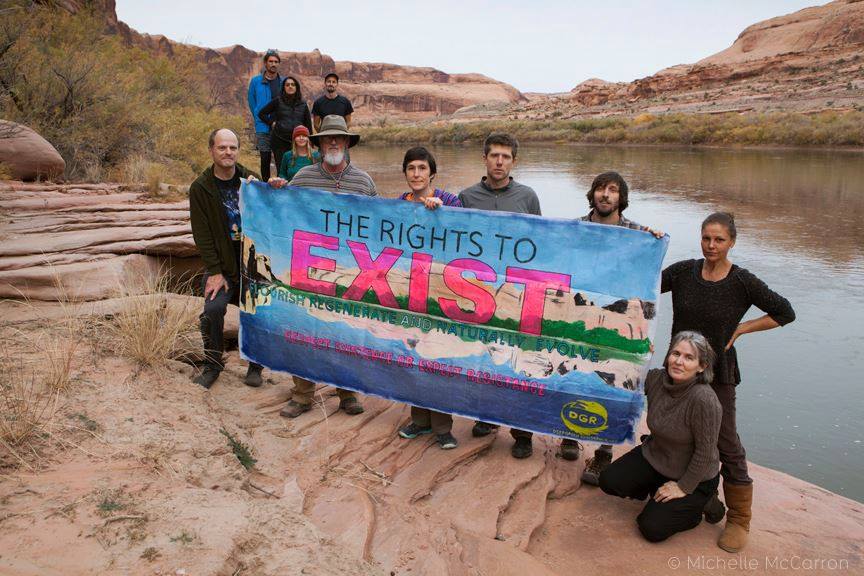
by Deep Green Resistance News Service | Dec 11, 2017 | Lobbying
Our first-in-the-nation lawsuit seeking personhood for the Colorado River was dismissed. After the Colorado Attorney General filed a motion to dismiss and threatened sanctions against attorney Jason Flores-Williams for the unforgivable act of requesting rights for nature, Flores-Williams withdrew our case.
When I agreed to serve as a next friend, or guardian, of the Colorado River, I saw the opportunity as a win-win. Either, we would win the lawsuit and the Colorado River would gain a powerful new legal tool to protect herself. Or, the lawsuit would be defeated proving that the American legal system privileges corporate rights to destroy the natural world over the natural world’s right to exist.
I knew it was highly unlikely that corporations, the courts, and the Colorado Attorney General would let rights of nature gain traction in American law. I wanted to be there, when the case failed, to remind everyone who invested hope in our cause that lawsuits are not the only way change is made.
I do not want this essay to come off like I am saying “I told you so.” I am heartbroken. A small part of me clung to the hope that Flores-Williams could resist the threats, that the Colorado Attorney General would, at least, litigate the case on the merits, and that the legal system would do the right thing. This hope, of course, was misguided.
***

Federal Building, Denver, Colorado (Photo: Deanna Meyer)
Several weeks ago, I wrote for the San Diego Free Press, “When has the American legal system been concerned with doing the right thing? While every ounce of my being hopes we win, if we lose, I want you to know why. I want you to be angry. And, I want you to possess an analysis that enables you to direct your anger at the proper targets.”
We lost because the American government and legal system are designed to ensure that corporations maintain the right to destroy nature for profit. We faced a centuries-old American legal tradition that defines nature as property. Property rights grant property owners the power to consume and destroy their property. The Colorado River is defined as property, and those who own her, possess the right to use her, extract her, destroy her – and they are. Because corporations also wield most of the world’s wealth, they have the most power to gain property rights over nature. Or, in other words, they have the most power to buy living non-human communities to turn them into dead, human products.
Making matters worse, the American legal system grants corporations the same rights as citizens. So, courts recognize corporate constitutional rights to free speech, protections from search and seizure, and guarantees to due process, equal protection, and reimbursement for lost future profits. One of the worst political ironies of our time is that abstract legal contraptions like corporations have rights, but the natural communities who give us life don’t.
It’s not just that corporations, and the courts and governments that protect them, will not let the rights of nature movement take hold; corporations cannot let the rights of nature take hold. They cannot let the rights of nature take hold because granting nature the rights to exist, flourish, regenerate, and naturally evolve would restrict corporate access to the natural world, which is the very source of corporate power.
Corporations gain their power by turning nature into commodities, which are then sold for profit. The more nature corporations can turn into commodities, the more profits they make. And, the more profits they make, the more nature corporations can turn into commodities. If this cycle does not stop, the planet’s life support systems will collapse.
In order to understand corporate dependence on the natural world, consider the five most powerful corporations according to this year’s Fortune 500 list: Walmart, Berkshire Hathaway, Apple, Exxon Mobil, and McKesson. Walmart, for example, depends on its ability to cheaply manufacture, distribute, and sell products as diverse as clothes, beauty items, toys, and food. To manufacture and distribute, a corporation must have access to raw materials to turn into products and must have access to energy to deliver those products. This is an abstract way of saying that Walmart must clear-cut (or pay someone to clearcut) living forests for wood, must rip-up (or pay someone to rip-up) living grasslands for agriculture, and must destroy (or pay someone to destroy) mountains and subterranean earth to extract oil for plastics, for the energy required to manufacture, and to power the planes, ships, and trucks that carry their products to markets around the world.
The same goes for Berkshire Hathaway who manages factory farms while running Dairy Queen, who burns massive amounts of fossil fuels while running BNSF Railway, who engages in one of the most destructive agricultural processes – cotton farming – while running Fruit of the Loom, and who perpetuates an ancient, bloody form of mining while running Helzberg Diamonds. Apple, similarly, could not produce iPods and iPhones without highly oppressive rare earth mining. McKesson could not create its pharmaceuticals without the highly toxic industrial processes that yield the necessary chemicals. Do we even need to talk about Exxon Mobil?
The rights of nature are diametrically opposed to corporate rights. Environmental philosopher John Livingston describes this opposition: “We sometimes forget that every time a court or a legislature – or even custom – confers or confirms a right in someone, someone else’s right is nibbled at: the right of women to equal employment opportunity is an infringement of the freedom of misogynist employers; the right to make a profit is at someone else’s cost; the right to run a motorcycle or a snowmobile reduces someone else’s right to peace and quiet in his own backyard; the rights of embryos impinge upon the rights of the women who carry them. And so on.”
Corporations cannot allow the Colorado River to possess rights because her rights to exist, flourish, regenerate, and naturally evolve may trump their rights to destroy her for profit. This makes the rights of nature a dangerous idea.
***

Federal Building, Denver, Colorado (Photo: Deanna Meyer)
But, the natural world needs more than dangerous ideas.
After we filed the lawsuit, I spent a month traveling with the Colorado River. As a “next friend” or guardian of the river, I agreed to represent her interests in court. To better understand her interests, I set out with the brilliant photographer Michelle McCarron to ask the river, “What do you need?”
I was naive to believe I could receive her answer in a month. After a month, I had only traveled the northern third of the river from her headwaters in La Poudre Pass, CO to just north of the Confluence where the Green River joins her in Canyonlands National Park. It wasn’t that she didn’t try to answer. She answered. And, her answer overwhelmed me.
In La Poudre Pass, standing in half a foot of snow in mid-October, she told me she needs snowpack and lamented that climate change causes less and less snow to fall. Near Grand Lake, where her waters are pumped through an industrial tunnel under Rocky Mountain National Park and across the Continental Divide, she showed me how theft is weakening her. In the orchards of Palisade, CO, where she is lacerated with ditches and canals to grow peaches and grapes, she begged to flow to willow thickets and marshes, instead, where she could grow birds and fish. Through the red rock near Moab, UT, where the wind sings in praise across the canyons the river has sculpted, she shuddered and whispered about the new, concrete walls that dam her path and that she cannot topple.
I will need much longer than a month to listen to everything the Colorado River needs. But, in all the time I spent listening, I did not hear her speak of a judge’s gavel, of evidentiary proceedings, or of the State of Colorado’s motion to dismiss. She cited no precedent, no binding legal authority, and no argument made by silver-tongued attorneys. She did not fear questions of jurisdiction or the threat of sanctions.
No, the Colorado River’s needs are real and physical. She needs snowpack. She needs a climate that facilitates her replenishment. She needs humans to stop manipulating her flows. She needs industry to stop wasting her waters on cash crops when wild beings are desperate for her. She needs dams to be removed.
We can give the Colorado River what she needs. We can stop burning fossil fuels. We can fill in the ditches and canals. We can let the desert reclaim the peach orchards and vineyards. We can, finally, remove dams.
Winning rights for the Colorado River would have helped, but they are not necessary. Better than the right to naturally evolve is naturally evolving. Better than the right to replenish is replenishing. Better than the right to exist is existing. And, better than the right to flourish is flourishing. Yes, it would have been a hell of a lot easier, if we could have gained a court order to remove dams along the Colorado River. But, court orders aren’t the only way dams fall.
When those who are supposed to protect us fail to do the right thing, we have to do it for them. There are recent examples of activists putting this principle into practice. On October 11, 2016, five climate activists (now famous as the “Valve Turners”) traveled to remote locations in North Dakota, Montana, Minnesota, and Washington state and turned shut-off valves on five pipelines carrying tar sands oil from Alberta, Canada into the United States. Elected officials would not shut down oil pipelines, so the Valve Turners did it for them.
Jessica Reznicek and Ruby Montoya, two brave women involved in Iowa’s Catholic Worker social justice movement, began a sabotage campaign against the Dakota Access Pipeline on Election Day 2016. Reznicek and Montoya burned heavy construction equipment, pierced steel pipes, and used oxyacetylene cutting torches to damage exposed empty pipeline valves. These actions delayed completion of the pipeline for weeks. Elected officials failed to stop the Dakota Access Pipeline, so Reznicek and Montoya stopped it for them.
The brave actions of the Valve Turners and Reznicek and Montoya notwithstanding, most of us are engaged in tactics that leave it up to someone else to do the right thing. The dismissal of our lawsuit is one more failure in a long list of failures to recognize the power we do possess and to use that power to protect the natural world. We fail and Earth continues to heat up. We fail and human population continues to grow exponentially. We fail and the rate of species’ extinction intensifies. Each failure begs us to answer the question: Why do we still seek change through means that have never worked?





















